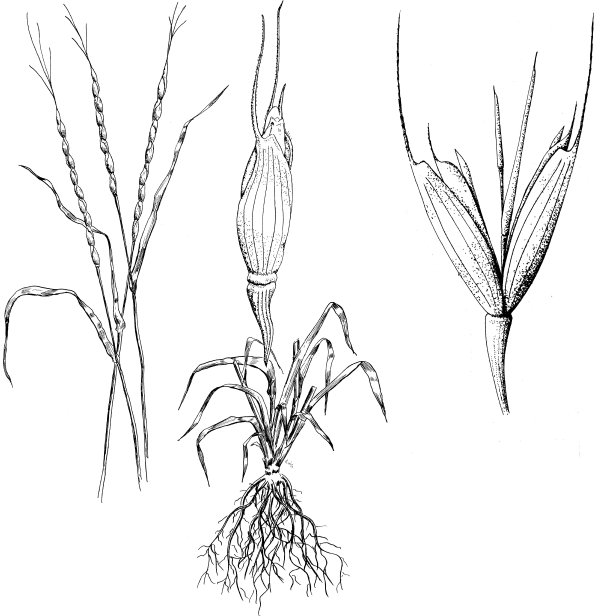
Aegilops cylindrica Host. Jointed Goatgrass Habit: Loosely-tufted winter annual. Culms: 20-80 cm. tall, erect, branching at base, pubescent or glabrous. Blades: Leaves flat, rolled in the bud, rough, often more or less pilose, 1-3 mm. wide, 2-12 cm long, auricles inconspicuous or absent. Sheaths: Shorter than the internodes, open. Ligule: Membranous, about 1 mm. long. Inflorescence: Terminal spike, long-cylindric, rachis internodes 6-8 mm. long, usually disarticulating near the base at maturity, falling entire, or finally disarticulating between the spikelets. Spikelets: Few (5-10), 8-10 mm. long, 2-4-flowered, single and alternate oblong-cylindric, flatwise at each joint and partly surrounded by the rachis, the joints thickened at the summit, glabrous to hispid, plano-convex. Glumes: Indurate, many-nerved, 6-10 mm long, keeled at one side, the awn an extension of the keel, the main nerve of the other side ending in a short tooth, asymmetrical, convex, both awned with longer awns on the upper spikelets. Lemmas: 2-lobed at the apex and awned between the lobes, awns of uppermost spikelets like those of the glumes, awns very scabrous, those of the upper spikelets about 5 cm. long, of the lower spikelets progressively shorter. Palea: 2-keeled, ciliate. Fruit: Grain pubescent at the apex, free, ripening a little in advance of wheat. Habitat: Fields and waste places. May-June. Kansas Range: Throughout Remarks: Not readily distinguishable from wheat in the vegetative stages. The spikes shatter at or just before the harvesting of the wheat. Introduced from Eurasia. Synonyms: Aegilops cylindrica Host var. rubiginosa Popova Aegilops tauschii auct. non Coss.